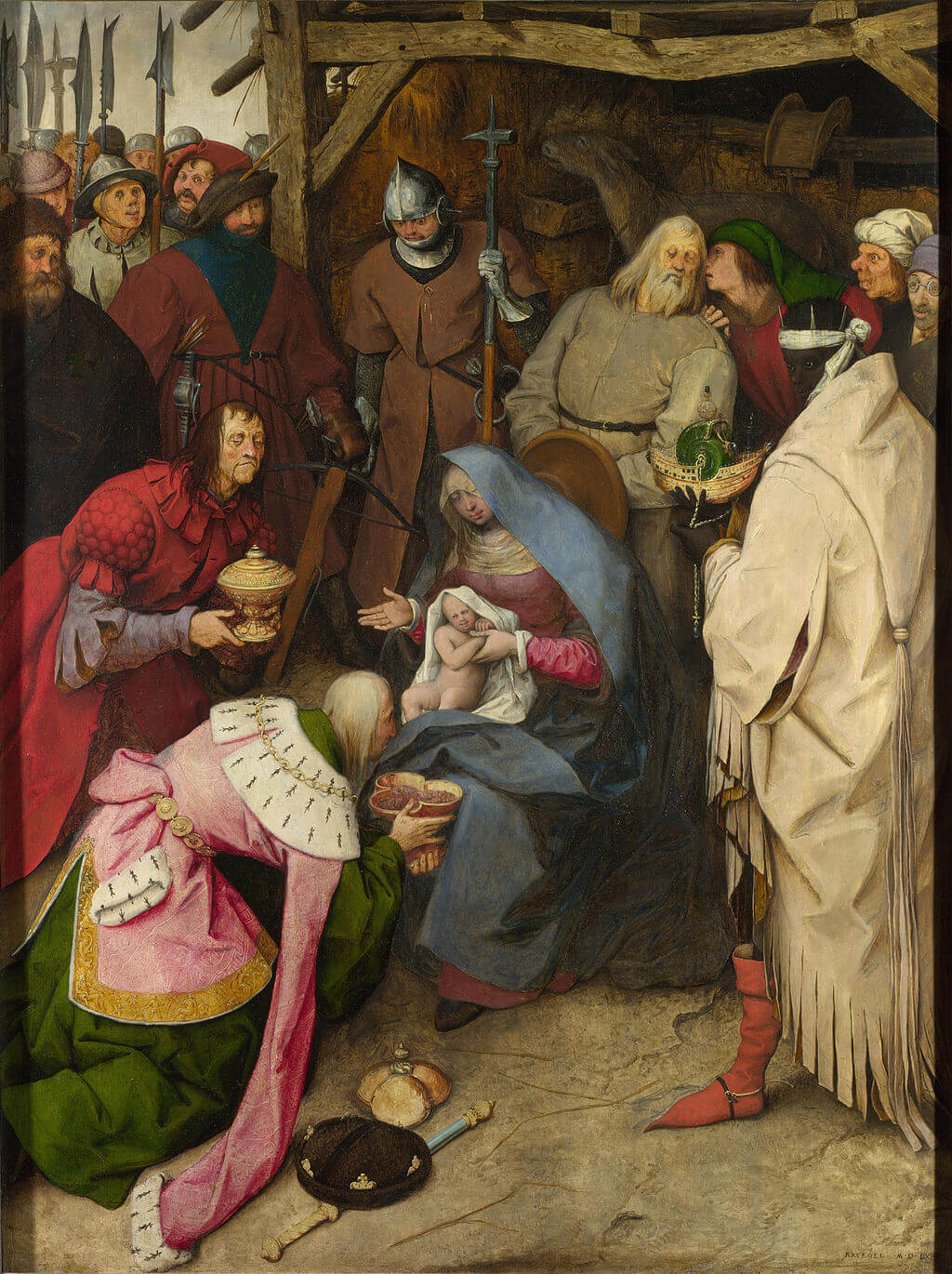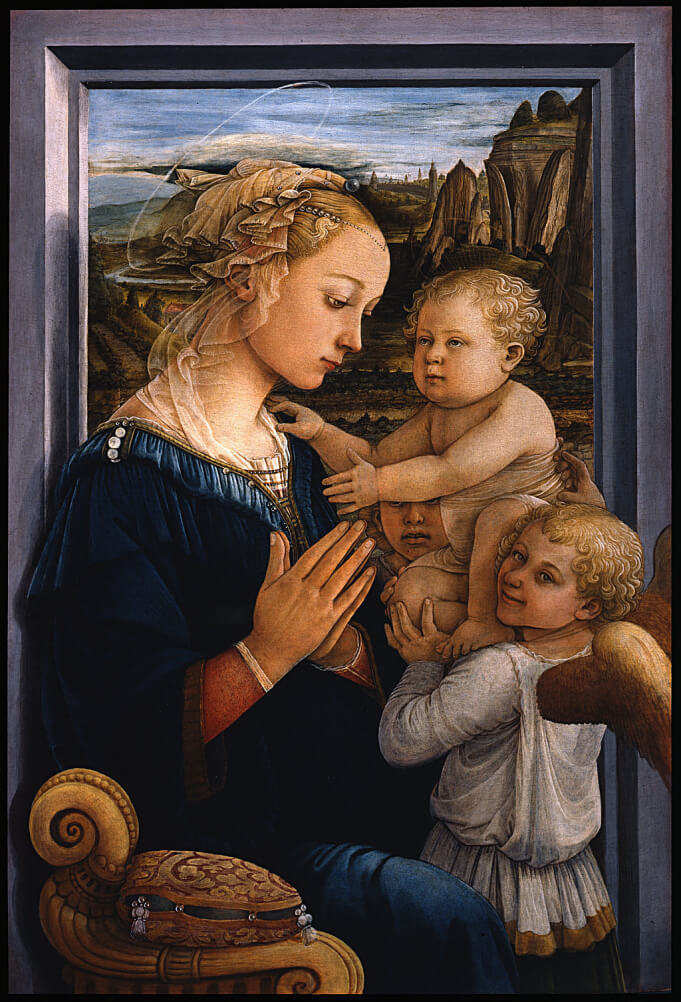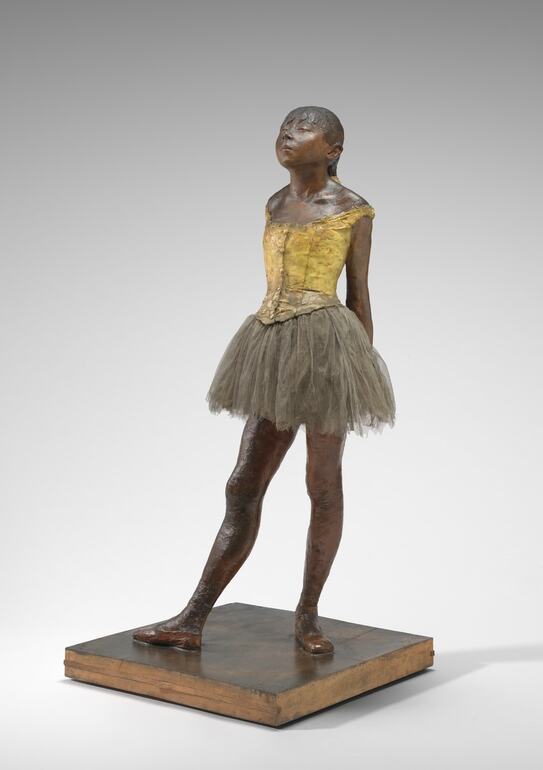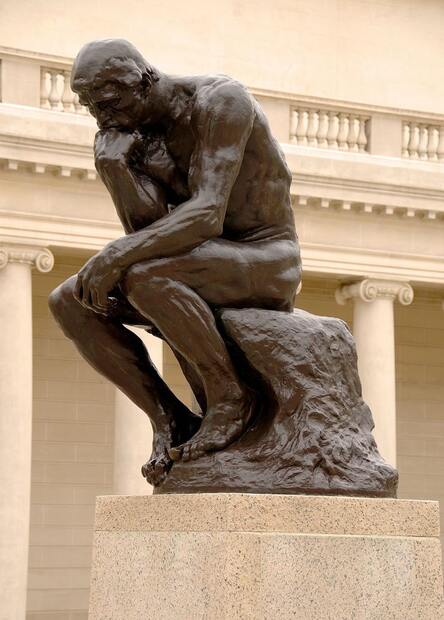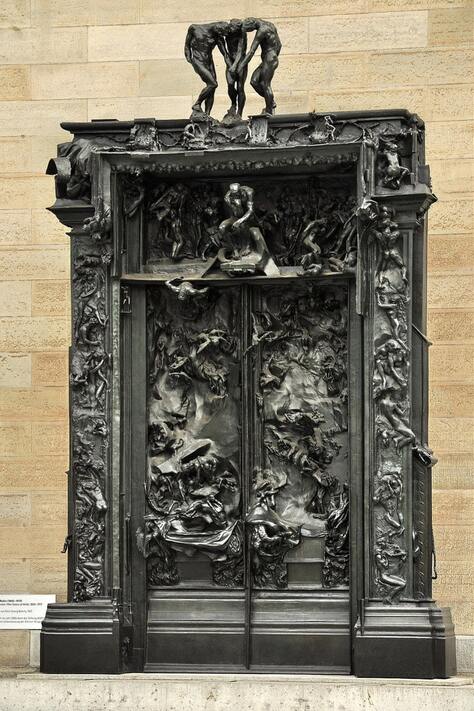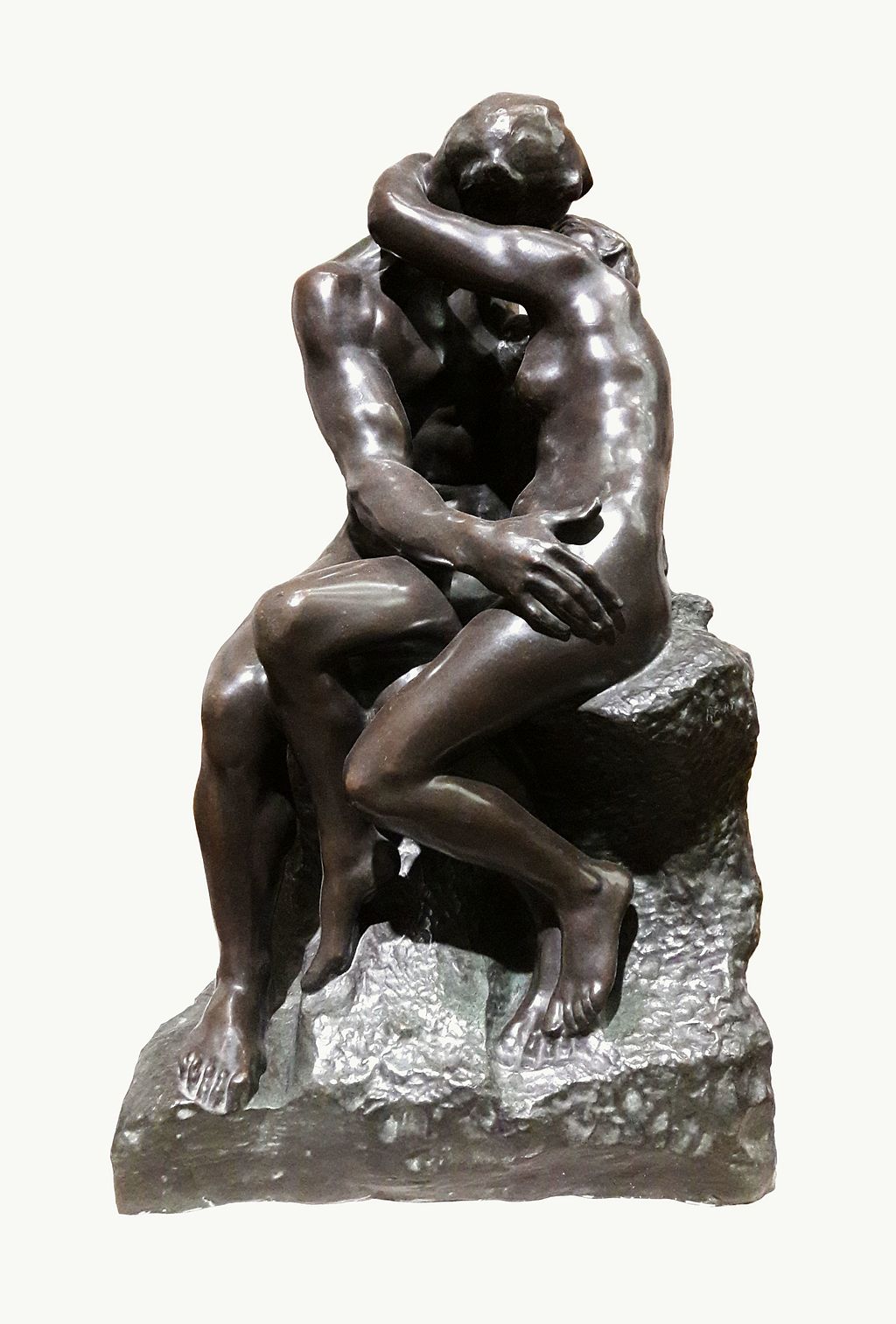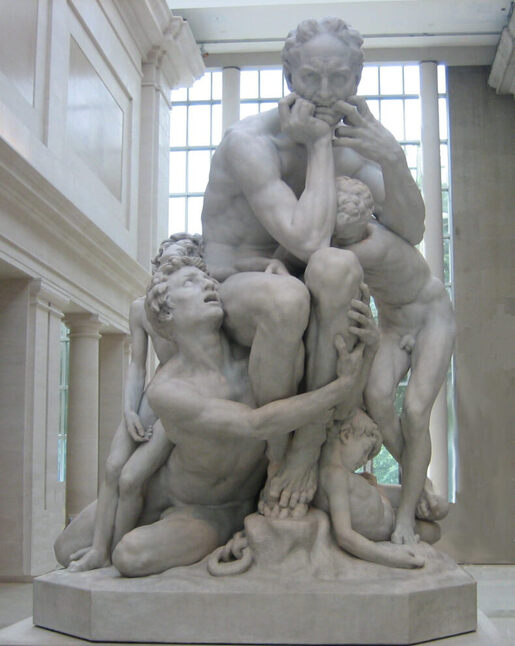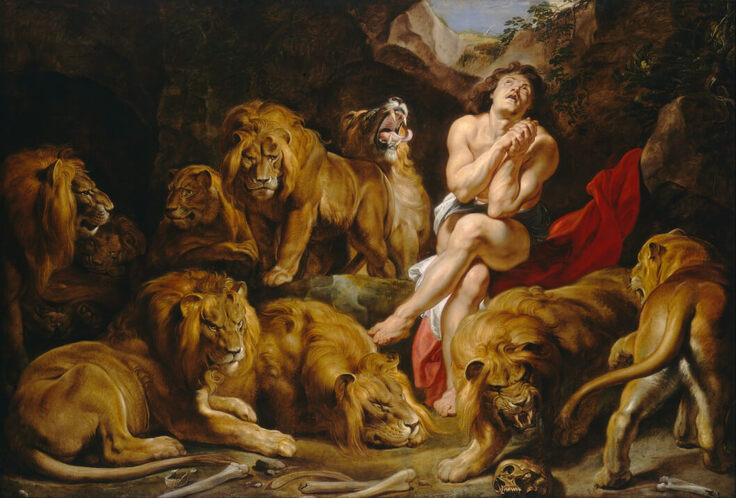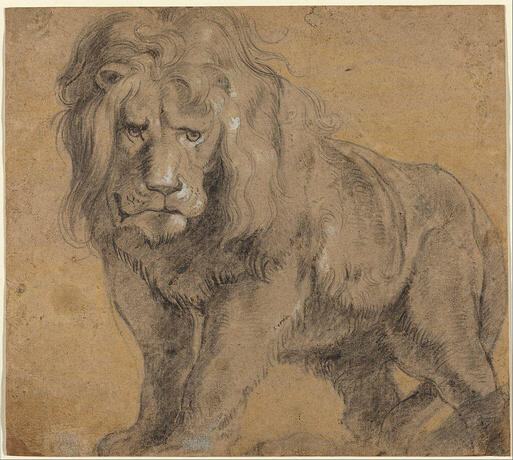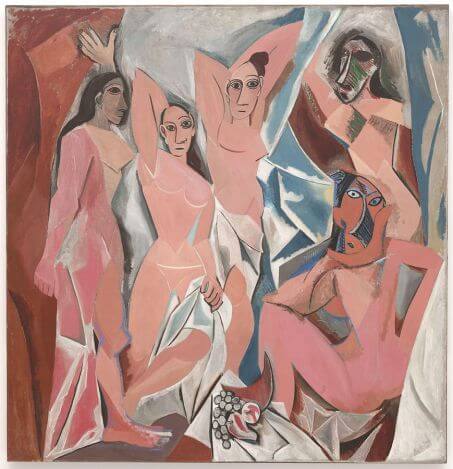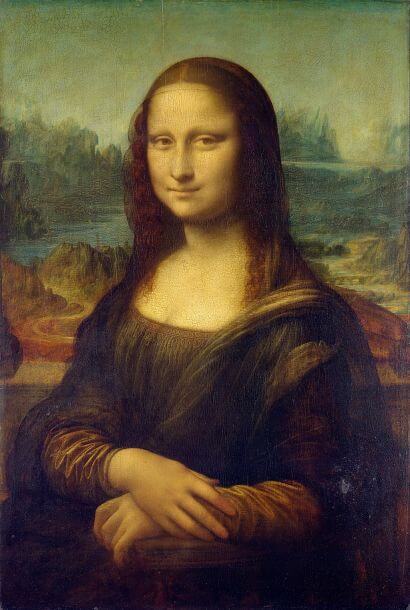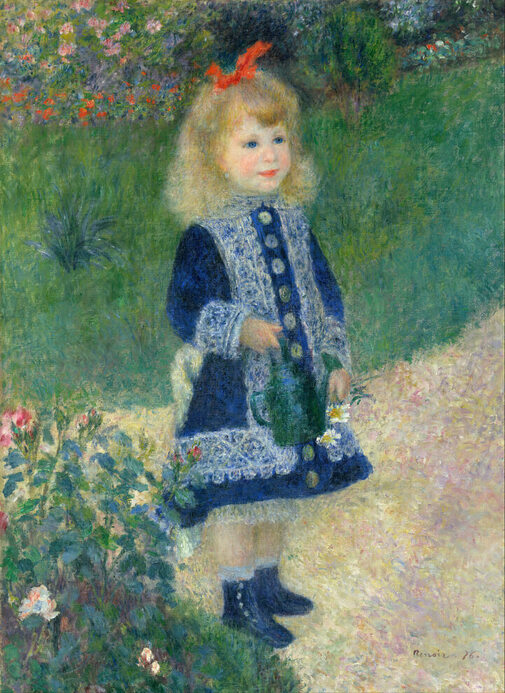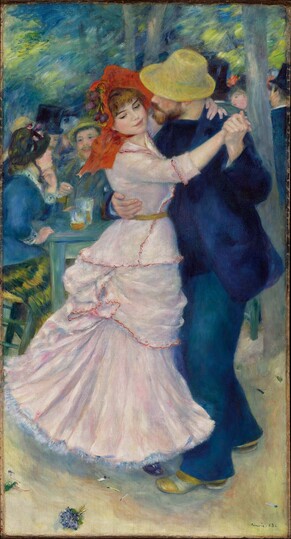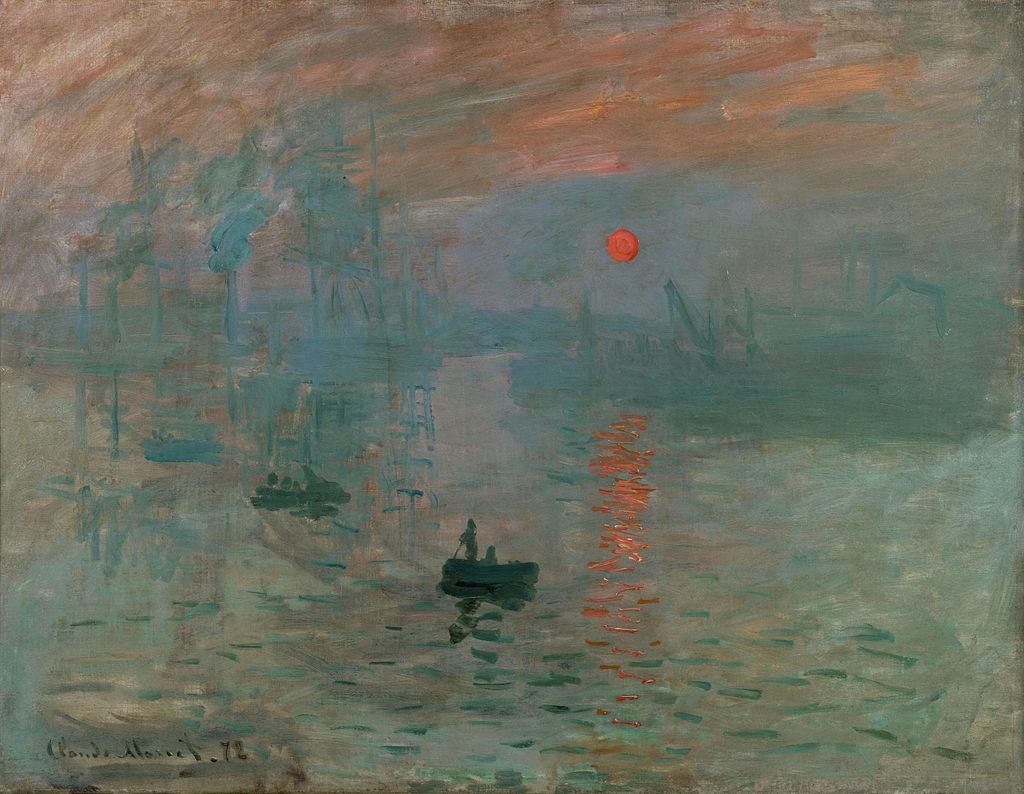|
Where? Gallery 4 of the National Gallery of Art
When? Between 1440 and 1460 Commissioned by? Most likely the Medici family What do you see? This tondo in a gold frame shows hundreds of people lining up to worship Baby Jesus. The line starts at the top right of the painting, goes around the back of the stable and the white building, and continues on the left side of the painting where people are entering under the arch. On the bottom right, the Holy Family is depicted. The Virgin Mary is wearing a blue dress and has Baby Jesus on her lap. You can see some pomegranate seeds next to the left hand of Jesus. To Mary’s right is Saint Joseph. To their left, you can see the typical donkey, ox, and manger. Behind and to the right of Mary and Joseph, you can see the three shepherds present at the birthplace of Jesus. In front of the line of people are the three Magi (also known as the three wise men or three kings) and behind them is their following. The first Magus is kneeling down in front of Jesus and touches his right foot. Jesus raises his right hand to bless him. The other two Magi are waiting behind him. The horses of the Magi are taken care of in the stable. Next to the stable is a group of blind and disabled people. Above them is a white architectural structure in decay and on top of this structure stands a group of five almost naked people. The painting contains various animals, such as cows, horses, camels, a donkey, an ox, a falcon, a peacock, a pheasant, and a dog. The two birds on the right of the stable probably represent a falcon (or a goshawk) attacking a pheasant. On the top right, next to the mountaintop, you can see even more faces cluttered together. Also, below the arch on the left, you can see sketches of more people and animals. Backstory: This painting is also known as the Washington Tondo or the Cook Tondo (named after a former owner of the painting). Fra Angelico started this painting, but before completing it, he was called to Rome by the Pope to complete several commissions in the Saint Peter and the Vatican Palace. Fra Filippo Lippi was then commissioned to finish the painting. In addition, it may be the case that several people in the workshops of both friars may have contributed to the painting. It is not entirely clear who painted which parts of the painting. The general idea is that Fra Angelico painted the figures with the thinner faces (like Mary) and Lippi painted the figures with the broader faces (like Saint Joseph and the Magus holding the foot of Jesus). It is thought that Filippo Lippi completed the majority of the painting. Symbolism: The painting contains various symbolic references:
Why the Adoration of the Magi? This theme was popular among Renaissance painters and has been painted by, among others, Botticelli, Pieter Bruegel the Elder, and Leonardo da Vinci. For example, Adoration of the Kings by Bruegel can be found in the National Gallery in London and Adoration of the Magi by Botticelli can be found in the Uffizi Museum in Florence. An important argument for the popularity of the adoration of the Magi theme is that artists could paint the luxury and colorfulness of the costumes of the Magi and their followers. This theme reflects the biblical story in Matthew 2 about the three kings who traveled a large distance following a big star to worship Baby Jesus. They brought three gifts for Jesus: gold, frankincense, and myrrh.
Who is Fra Angelico? Born as Guido di Petro around 1395, he was better known as Fra Angelico or Il Beato Angelico. He lived a very pious life and died in 1455. He started his career as a manuscript illustrator and moved on to become a painter of frescos and paintings.
He was beatified in 1982 by Pope John Paul II, because of his pious life and the amazing quality of his paintings. He was especially good in painting the most beautiful depictions of the Virgin Mary. One of his great works is the Coronation of the Virgin in the Uffizi Museum. Who is Filippo Lippi? Fra Filippo Lippi (1406-1469) was born in Florence. After his parents died and his aunt could not take care of him anymore, he was sent to a Carmelite convent. Unlike Fra Angelico, he lived a far-from-pious life, though he officially remained a friar throughout his life. He left the convent at age 26 and later in his life he even married and got a child, the well-known painter, Filippino Lippi. The Medici family recognized the talents of Filippo Lippi, and during his career, he completed at least nine paintings for them. One of his most famous works is the Madonna and Child with Two Angels in the Uffizi Museum.
Fun fact: An analysis by the National Gallery of Art has revealed that this painting was created over an extended period of time. It also seems that some of the animals in the painting were not initially included in the design, but only added later on, possibly by another painter than Fra Angelico and Filippo Lippi.
Analysis revealed, specifically, that the peacock, falcon, pheasant, and hunting dog were added on top of areas that were already painted. This was probably under the influence of the Medici brothers Piero and Giovanni. Note that the birds are painted bigger than they should realistically be, compared to the rest of the painting, to emphasize their symbolism. They distract the viewer from the real theme of the painting. Interested in a copy for yourself? Poster or canvas.
2 Comments
Where?
What do you see? A young dancer of fourteen years old is shown at 70 percent of her real size (the sculpture is a bit taller than 3 foot or about 1 meter). She seems relaxed and is standing in ballet’s fourth position (there are seven positions for the feet in ballet, and the ballerina here has her feet in open fourth position – about 12 inches apart and facing different directions). The girl is sculpted realistically and Degas intends to show the hard life of a ballet dancer and what it does to her body. Her back leg supports most of her weight. She has thin legs and arms, holds her arms behind her back, and has her hands clasped together. She confidently holds up her chin, pushes her shoulders back, and her eyes are half closed. She wears ballet shoes, a real tutu made of tarlatan, and a gold-colored bodice (a vest) made of linen. The girl also wears a real ribbon in her plaited hair. Degas used real hair for this sculpture, which he covered in wax.
Copies: The National Gallery of Art holds two statues (the original wax statue and a bronze casting) of the Little Dancer Aged Fourteen as well as two nude studies for this statue. When Degas died, about 150 statues were found in his studio of which only one of the versions in the National Gallery of Art had been shown to the public at an exhibition. Many of these statues were in bad shape, but about half of these statues were repaired after his death. The National Gallery of Art has many of these original statues.
The surviving family of Degas decided to create about 22 bronze casts of these statues. Because of this, nowadays, bronze copies of the Little Dancer Aged Fourteen can be found in many other locations besides the ones mentioned on the top. For example, the statue is also in the the Art Institute of Chicago, Harvard Art Museums, Metropolitan Museum of Art (currently not on view), and the Norton Simon Museum. One of the bronze copies of the Little Dancer Aged Fourteen was sold in 2009 for $19 million.
Who is Degas? Hilaire-Germain-Edgar De Gas (1834-1917) was born in Paris. Whereas he spent most of his life in Paris, he also lived for three years in Italy and spent time in Florence, Naples, and Rome. He started as a more traditional painter by creating historical stories and portraits, but during the 1860s he changed his style and became one of the founders of Impressionism, together with artists like Cézanne, Manet, Monet, Pissarro, and Renoir.
Later on, he changed his focus and started to paint scenes from everyday life with a particular interest in dancers, theater, and horse racing. He moved on to focus on more realistic paintings, and one such example is Interior in the Philadelphia Museum of Art. He made statues mainly as training to understand the anatomy and movements of people.
Fun fact: When Degas showed this sculpture at an Impressionist exhibition in Paris in 1881, many people did not like it at all. For example, some people called the sculpture a monkey. It also did not help that the sculpture was on display in a glass vitrine. Sculptures typically were idealized versions of well-known people created in marble. Instead, Degas created an unknown young girl from Paris, and the girl did not look at all like a goddess. On top of that, he created this sculpture from beeswax and he added objects like a tutu to the statue. Because of the negative reactions Degas got, he removed the statue from the exhibition and stored it in his studio until his death.
Interested in a copy for yourself? Canvas or statue (Amazon links).
Where?
When? Rodin created the original sculpture in 1881. He created the first monumental-size sculpture in 1903 and after this many casts of the sculpture have been created, even after his death in 1917. What do you see? A sculpture of a muscular, naked man sitting on a rock. The man is in deep thought and uses his whole body to think. His head is bent forward and leans on his right hand. His wrinkled face, knitted eyebrows, swollen nostrils, compressed lips, and absent-minded gaze reinforce the idea that the man is deep in his thoughts and is completely unaware of the world around him. The man is struggling with his thoughts with every part of his body. Almost no part of his body is relaxed. Most muscles are tense, which is clear by looking at the clenched fist, the arched back, the legs below his body, and the squeezed toes. The statue is over six feet tall making the figure larger than life. It was the intention of Rodin to put the independent sculpture on top of a pedestal such that it would make a colossal impression on the viewers. Backstory: In 1880, Rodin received a large commission from the Directorate of Fine Arts in France to create the entrance doors for a new museum that was to be built (but never opened in the end). He was given the freedom to choose his own theme and decided on creating a scene from Dante’s book Inferno. Rodin was supposed to finish the project in five years but continued to work on the project for 37 years until his death in 1917. The doors – named The Gates of Hell – would eventually include a total of 180 different figures, and they would form the basis for many of Rodin’s most famous statues. Rodin originally created all figures in plaster, and the doors were then to be cast in bronze. The central and the most important part Rodin created for these doors was the statue of The Thinker (Le Penseur in French) who sits right above the two doors with all the characters from the Inferno behind him. The statue was about 27 inches (70 cm) high.
Multiple versions: The statue of The Thinker can be found all around the world. Rodin created the first version of this statue in plaster in 1881. In 1903, he completed the first monumental-size version of this statue. He considered it to be a remarkable piece and wrote to the client of his first bronze casting that he would ensure that only a few copies of the statue would ever be made. However, he did not keep his word.
During Rodin’s life, already more than 20 versions of The Thinker were produced. And after his death, the right for reproduction was turned over to the Republic of France. Nowadays, more than 70 bronze and plaster versions exist and are on display in Asia, Australia, Europe, North America, and South America. Interpretation: There are various interpretations of what and who The Thinker represents. When initially creating this statue as part of The Gates of Hell, Rodin meant the figure to represent Dante pondering about the fate of the damned people entering through the Gates of Hell. This interpretation is based on Dante’s book Inferno, the first part of his trilogy known as The Divine Comedy. When Rodin started to create independent versions, he started to consider different interpretations. Overall, he considered the statue to represent the struggle of the human mind. But he also started to see hope in it. The thoughts slowly become clear, and the man turns from a thinker, into a dreamer, and finally into a creator. Over time, other interpretations have also been given. Some consider the statue to represent Rodin himself. Others interpret the figure as Adam contemplating the sin he committed in Paradise. Who is Rodin? François Auguste René Rodin was born in 1840 in Paris, where he died 77 years later in 1917. He was rejected three times by the leading art school in Paris, the École des Beaux-Arts. It forced him to educate himself differently and this has contributed to his unique style. He was inspired by some of the great Renaissance sculptors like Donatello and Michelangelo. Most of Rodin's famous sculptures were originally intended for his commission of The Gates of Hell. Over time, he realized that he could turn many elements of The Gates of Hell into separate statues and some of these statues have achieved world fame. Among them are The Three Shades and The Kiss. Many of Rodin’s statues have been cast multiple times in bronze which means that his statues have spread across the world.
Why a bronze statue? Bronze is a combination of different metals. It consists primarily of copper (typically 85-90%) and tin (typically 10-15%), but can also contain minor quantities of other metals or nonmetals. It is an attractive material for sculptors for the following reasons.
Fun fact: While The Thinker is one of the most famous statues in the world, Rodin initially named this statue “the poet.” Later it was renamed based on suggestions by foundry workers that the sculpture was quite similar to a sculpture by Michelangelo on Lorenzo de’ Medici, Duke of Urbino. This sculpture was more popularly known as “Il Penseroso” (The Thinker), and this name was also given to Rodin’s statue. The Thinker also shows some resemblance to Ugolino and His Sons which was created by Jean-Baptiste Carpeaux in the 1860s.
Where? Prints are part of the collections of several museum around the world, including the Ashmolean Museum, National Gallery of Art, National Galleries Scotland, Philadelphia Museum of Art, and the Rijksmuseum.
When? 1581 What? Engraving on laid paper: plate: 30.6 x 20.8 cm; sheet: 54.2 x 42.9 cm. What do you see? A young nude boy sits on a pile of rocks, intently focused on removing a thorn from his bare foot. The statue sits in the corner of a room or foyer. Puffy clouds visible in the upper part of the window on the left help to define the available light source. Engraving techniques produce the textures that indicate the depth of the walls and the space the statue occupies. Each shadow is created by a multitude of fine lines, overlapping lines, and cross-hatching. The marble pedestal supporting the statue raises the young boy so the viewer can see the scene from below. His right foot does not touch the ground or rest as he tries to remove this thorn without inflicting more pain. The story and original sculpture date back to a Classical Roman marble that is said to be a copy of an even earlier Grecian bronze rendition lost in the 3rd century B.C. Reproductions of the statue were one of Rome's most widely admired antiquities, and drawings and prints were popular and in demand. A copy of the original ancient statue can be found at Palazzo dei Conservatori, which is part of the Capitoline Museums in Rome. It is recorded as having been there since 1499-1500.
Where? Gallery 45 of the National Gallery of Art
When? 1614-1618 Commissioned by? Unknown, but possibly Rubens created this as a showpiece for his studio. What do you see? Daniel is in the lions’ den surrounded by life-size lions. He sits on a colorful red cloth and has a white cloth wrapped around him. His body is tense with his legs crossed and his arms together. Given the light in the background, it seems that this painting captures the moment in the morning after Daniel has spent a full night in the den. Daniel is praying with his hands folded and he is looking up into the air. Some lions are sleeping, others are looking straight at us, and others are roaring or growling. There are nine lions and lionesses. In the foreground are the bones and a skull as evidence that the lions have already eaten some people. However, a young Daniel is sitting alive in the middle of the den. Notice that according to the Biblical story, Daniel was much older when he was thrown into the lions’ den, probably around 80 years old.
The painting is based on the Biblical story in the Book of Daniel, chapter 6. In short, Daniel is a high-level administrator for the Persian king Darius. He is doing so well that Darius wants to promote Daniel to be in charge of the full kingdom. The other administrators hatch a plan to trap Daniel. They convince Darius to issue a decree that in the next 30 days no one could pray to any god or human other than king Darius. As Daniel continues to pray to his God, he is sentenced to be thrown into the lions' den which nobody could survive. Darius says to Daniel before he is thrown in the den: “May your God, whom you serve continually, rescue you!” A big stone then covers the den.
The next morning Darius checks on Daniel and finds him still alive without any scratch. After that, Darius decided to throw all the administrators and their families in the lions’ den next, and they were all killed before they even reached the floor. Symbolism: The message of this painting reflects the message from the Biblical story of Daniel in the lions’ den: If you trust in God, he will protect you from no matter what, even from a pride of hungry lions. This story also symbolizes the resurrection of Jesus from the dead. The lions symbolize the powerful rulers on earth. Daniel is praying and looking upwards to Heaven, which symbolizes his faith in God. The skull in the foreground refers to Golgotha, the place where Jesus was crucified. The red cloth refers to the blood of Jesus.
Who is Rubens? Peter Paul Rubens (1577-1640) is a Flemish painter. He was born in Siegen, which is now in Germany, and died in Antwerp, Belgium. Together with Caravaggio, Rubens was one of the most well-known painters of his time. He used a Baroque style of painting.
In 1600, Rubens traveled to Italy, where he stayed for eight years. He spent time in Venice, Florence, and Rome and got inspired by the works of artists like Michelangelo, Raphael, and Titian. After this period he moved back to Belgium, where he set up his studio. Together with his many students and apprentices, he produced a very large number of paintings during his life. Fun fact: Rubens liked to include wild animals in his paintings and was often asked to paint hunting scenes. As he was one of the most dramatic painters of his time, he was perfectly suited to create some crazy hunting scenes. He could study most of these wild animals in the menageries that some of the richest people liked to have around that time. One thing he had to change, however, was to paint the animals like they would behave in the wild as opposed to the often tamed animals he observed in the menageries. In his different paintings, he included wild animals, such as bears, crocodiles, foxes, hippos, lions, tigers, and wolfs. These hunting scenes were always on commission, and they were a great way for Rubens to earn money. See, for example, the painting of The Tiger Hunt by Rubens. Interested in a copy for yourself? Poster or canvas
Where? Gallery 217C of the East Building of the National Gallery of Art
When? 1905 What do you see? A group of six saltimbanques (who are traveling circus artists) against a pale background with a cloudy blue sky. The people look somber and have little expression on their faces. Picasso intended to picture the isolation and melancholy of these people. The tall harlequin on the left probably represents Picasso. He wears a suit with diamond shapes on it. He holds one hand on his back, and with the other hand he holds a young girl with a basket of flowers. The obese man to the right of Picasso is a jester with the name Tio Pepe. He wears a bright red suit and a pointed jester hat and holds a bag over his shoulder. The young man to his left only wears his underwear and holds a drum on his shoulder. The boy to his left, wearing a colorful blue jacket, is a juggler. The woman on the right, with the bright orange-red skirt, probably represents the girlfriend of Picasso, Fernande Olivier. She wears a Mallorcan costume, and she has the same flowers on her head as the small girl has in her basket. To the left of the woman is a Spanish pitcher. Backstory: Saltimbanques were traveling circus artists who could do a variety of tricks. The word saltimbanques literally means “somersault over a bench.” Picasso created this painting during five different stages over a period of nine months. He sought for perfection and was not happy with the work at the end of the first four stages. The people in this painting seem to resemble Picasso and some his friends in Paris. The men from left to right resemble Picasso, Apollinaire, Andre Salmon, and Max Weber, and the woman on the right Fernande Olivier. Picasso did not name the painting himself as he usually did not give titles to his work. In 1931, Chester Dale bought this painting and it went to the National Gallery of Art after his death in 1962. What is the Rose Period? The Rose Period refers to the period between 1904 and 1906 in the career of Picasso. It follows the Blue Period, which was between 1901 and 1904. In the Blue Period, Picasso suffered from depression after the suicide of a good friend. He primarily used somber blue and blue-green colors and focused on painting themes like hopelessness, loneliness, and poverty. In 1904, Picasso got into a good relationship with Fernande Olivier and his style changed to more happy themes and colors. In the Rose Period, he primarily used colors like red, pink, and orange, and focused on themes like acrobats, clowns, and harlequins. His paintings during this period were mainly based on his intuition rather than the direct observation of the people he depicted. The harlequin dressed in clothes with a checkered pattern was a frequently returning figure in his works, just like you can see in this painting. Another example is At the Lapin Agile in the Metropolitan Museum of Art.
Who is Picasso? His full name is Pablo Diego José Francisco de Paula Juan Nepomuceno María de los Remedios Cipriano de la Santísima Trinidad Ruiz y Picasso. He was born in 1881 in Malaga, Spain, and died in 1972 in Mougins, France.
When Picasso was 19 years old, he traveled to Paris, the art capital of Europe during that time. Over the next few years, he lived partly in Paris and partly in Barcelona. In Paris, he frequently visited the circus (sometimes multiple times per week) and the theater with friends and found his inspiration to paint circus artists. In 1905, he met Henri Matisse in Paris and they became friends for life. Picasso created many masterpieces and one of the most famous works he created, right after the Rose Period, is Les Demoiselles d’Avignon in the Museum of Modern Art in New York.
Where? Gallery 6 of the National Gallery of Art
When? 1474 Commissioned for? Most likely, either the engagement or marriage of Ginevra de’ Benci. What do you see? The 16- or 17-year old Ginevra de Benci is painted. She is wearing a brown dress with blue laces and gold edges, and a black scarf. Below the dress she wears a subtle white blouse with a golden pin. She has a porcelain-like skin and her hair is styled in ringlets. Her expression is, one the one hand, a bit grumpy, and on the other hand, she seems proud. Her eyes emphasize this. Her left eye (for the viewer) is looking at the viewer, but her right eye seems to be looking down on something. Experts have interpreted the facial expression of Ginevra as an indication that she is not happy with the (upcoming) marriage. Note that Ginevra has only light eyebrows. Shaving the eyebrows was common at that time for women and can also be seen in the Mona Lisa by Leonardo da Vinci. Behind Ginevra is a juniper bush. The halo of spikes from the juniper leaves contrast nicely with the depiction of Ginevra. In the right background are the mountains, trees, water, a small town, and the hazy sky, which are typical for Leonardo da Vinci’s style.
Back of the painting: On the back of this painting is another painting from Leonardo da Vinci, called Wreath of Laurel, Palm, and Juniper. It shows a juniper sprig, with a circular arrangement of palm and laurel around it. It also includes the inscription “Virtutem Forma Decorat”, which means “beauty adorns virtue.”
Backstory: This painting was created to commemorate Ginevra de’ Benci’s engagement or marriage to Luigi di Bernardo Niccolini. Sources have shown that the wedding between both of them took place on January 15, 1474. Bernardo Niccolini was twice the age of Ginevra. During the Renaissance, women were typically only depicted when they got engaged or married.
This is the first known portrait that Leonardo da Vinci painted and the only painting of him in the Americas that is available for public viewing. It was bought in 1967 for $5 million. Symbolism: The juniper bush represents chastity, which was considered to be one of the most important moral standard for women in the Renaissance. At the same time, juniper is a reference to Ginevra’s name as juniper translates into Italian as “ginepro”. The laurel and palm on the back of the painting symbolize, respectively, the intelligence and moral values of Ginepra. However, the laurel and palm were also the personal emblem of Bernardo Bembo, who was thought to have a platonic affair with Ginevra. Bernardo Bembo was the Venetian ambassador to Florence, and he probably commissioned the back of this painting (and according to some also the front of the painting, but this is not proven). Who is Ginevra de’ Benci? Ginevra de’ Benci (born in 1457 or 1458) was the daughter of a wealthy Florentine banker. She was considered to be one of the most intellectual people of her time and was a poet. Later in her life, Ginevra was exiled at her own request because of an unknown illness and tragic love affair. Who is Leonardo da Vinci? Leonardo da Vinci (1452-1519) was born in the Italian village of Anchiano, which was very close to Vinci, which is where he got his name from. He was an architect, astronomer, engineer, inventor, mathematician, musician, painter, writer, and much more. Leonardo da Vinci is known to be one of the biggest multi-talented people that the world has ever seen. He created this painting while he was still a student of Andrea del Verrocchio. Other well-known paintings by Leonardo da Vinci include his Madonna Litta in the Hermitage Museum and Virgin of the Rocks in the Louvre.
Fun fact: About one-third of this painting is missing. At some point in history, someone cut off the lower third of the painting, probably because it was damaged. Based on a drawing of Leonardo da Vinci, it is believed that the part that is cut off probably shows Ginevra folding or crossing her hands in her lap. It is a pity that this part is missing as Leonardo was a specialist in drawing hands. With his diverse interests, he was obsessed by the anatomical correctness when he painted parts of the human body. Ginevra was possibly holding a flower in her hand to symbolize devotion.
Interested in a copy for yourself? Poster or canvas of Ginevra de' Benci; poster of Wreath of Laurel, Palm, and Juniper.
Where? Gallery 56 of the National Gallery of Art
When? 1851 Commissioned by? Paul Sigisbert Moitessier, the husband of Madame Moitessier. What do you see? Madame Moitessier is standing firmly and wears a black velvet dress with black lacing and a black lace band on top. She also has a black lace shawl wrapped around her middle. She seems to be ready to go to a party or the opera. Her face is symmetric and she was considered to be a very beautiful woman during her time. She stands against a pinkish background decorated with a flower pattern. Her neck and shoulders contrast nicely with the dress and the background. Notice how the neck transitions into the shoulders and how the shape of the shoulders looks a bit unrealistic. Her gaze is unfocused and resembles a bit the ancient Greek sculptures. In her right hand she holds her pearl necklace, and she has a folding fan in her left hand. She is richly decorated with jewelry to show her wealth. Her hair is beautifully decorated with roses. On the right, you can see a reading desk or mantel. On the left is a chair with a glove, a handkerchief, and a fur rug on top of it. Backstory: Madame Moitessier and her husband initially wanted a painting of her seated together with her daughter, but Ingres did not complete that painting until five years later. In 1851, they agreed on another portrait of her standing (which is this painting). Ingres completed this standing portrait within several months. Madame Moitessier was not completely happy with the painting. She found her arms to big and her eyes too far apart. Who is Madame Moitessier? Marie-Clotilde-Ines Moitessier (1821–1897) was the wife of Paul Sigisbert Moitessier, a wealthy banker and merchant who was about twenty years older than her. She was also known by her maiden name De Foucauld, which is the name inscribed at the top right of this painting. Madame Moitessier was the aunt of Charles de Foucauld, a famous French priest who was beatified by the Pope in 2005. Another portrait of Madame Moitessier: In 1856, Ingres finished another portrait of Madame Moitessier currently on display in the National Gallery in London. He started with that painting in 1844, but it took him 12 years to finish that work.
What is Neoclassicism? An art movement that started in Rome in the middle of the 18th century drawing inspiration from the classical period in ancient Greece and ancient Rome. Some of the main Meoclassical artists include Antonio Canova, Giovanni Paolo Panini, Jacques-Louis David, and his student Jean-Auguste-Dominique Ingres.
Neoclassic art is inspired by the old Roman and Greek art and focuses on simplicity and symmetry. The paintings, sculptures, and architecture in this style did not show much emotion, were more ordered and down-to-earth compared to the baroque style, and less playful compared to the rococo style.
Fun fact: One of the reasons that Ingres is considered to be a great portrait painter is that he started from scratch. He hired a nude model similar in shape to the person he wanted to paint (as those rich persons did not want to model nude) and started by drawing the body contours of that model. In that way, he could better paint how the dress would fit around that body. He put a lot of time into this initial stage. For example, if the model would wear a corset under the dress (which is probably the case for Madame Moitessier) he would first add the corset to the naked body before painting the dress.
Interested in a copy for yourself? Poster
Where? Gallery 85 of the National Gallery of Art
When? 1876 Commissioned by? Possibly for the art collection of Baron Achille Sellière What do you see? A young and pretty girl holds a green watering can in her right hand and two daisies in her left hand. She is probably around four years old and wears a knee-length, deep blue dress with extensive white lace on it. She also wears matching blue boots with white lace on the top. She has red lips, blue eyes, and rosy cheeks. She has a red bow in her long curly blonde hair. She seems to be content while watering the flowers. The girl stands on a light-colored footpath in the garden. The colors that Renoir used for the stones and dirt on the footpath contrast nicely with the green grass surrounding it. On the bottom left are a rose bush and some grass. In the background is more grass and a collection of flowers. In this painting, you can clearly see that Renoir applied the colors with individual touches and that he did not mix them on the canvas. This technique is typical of the Impressionist art style. No Shadow: Interestingly there is no shadow visible anywhere in this painting. The reason is that Renoir wanted to create an illuminating painting where the light radiates from the painting as soon as you see it. This painting is a good example of a painting that stands out from the rest of the paintings in the room in the National Gallery of Art. Another example of such an illuminating painting is Sunflowers by Van Gogh. You can see one of the versions of this painting in the Philadelphia Museum of Art and this painting also clearly stands out from the other paintings in the room. Another version is in the National Gallery in London. It is, however, also surprising that Renoir did not include a shadow in this painting, as he famously said: "No shadow is black. It always has a color. Nature knows only colors … white and black are not colors."
Backstory: According to some, this painting has been created in the garden of Claude Monet in Argenteuil, France, but this is not certain. The girl in this painting is probably a girl that lived near Renoir, possibly called Mademoiselle Leclere. He picked her because of her prettiness and especially her distinctive eyes.
This painting is a classical Impressionist painting as it focuses on the different colors and how they can be used to represent the effects of sunlight. Like many other Impressionist paintings, this work was painted while Renoir was outside (something that was uncommon in the period before Impressionism). However, at the same time, the simplicity of this painting is a first step in the direction of Post-Impressionism which is famous because of artists like Van Gogh. Who is Renoir? Pierre-Auguste Renoir (1841-1919) was a French impressionist painter. When he was three years old, his family moved to Paris and lived close to the Louvre. As a child, he often visited the Louvre to admire works of art. He developed himself into one of the best Impressionist painters and nowadays you can find some of his work in the Musée d'Orsay. Together with people like Manet, Monet, and Pissarro, he is one of the founders of the Impressionist art style. Renoir said that he painted for fun and painted scenes “which made me want to walk in it.” He continued to enjoy painting until the end of his life, even after he had developed arthritis and it became difficult to hold a brush. Some of his other great works include Dance at Bougival at the Museum of Fine Arts in Boston and La Promenade in the Getty Museum.
Fun fact: At the time of this painting, Renoir was still in a struggle for money. To generate money, Renoir decided to paint widely attractive scenes of women and children in the hope that these would sell more easily and possibly attract some commissions for portraits. These kind of scenes were in high demand in France at that time. His strategy paid off as by 1879 he had become a successful painter with some money which he used to travel around Europe and North Africa.
Interested in a copy for yourself? Poster or canvas.
Where? Gallery 85 of the National Gallery of Art
When? 1875 What do you see? Claude Monet painted his wife Camille and their eldest son Jean who are out for a stroll on a windy and sunny day. Monet captures a brief moment during some quality time with his family. Madame Monet and her son stand on a small hill given the position of Jean, and they are looking towards the painter Claude Monet. In the foreground is a field with yellow wildflowers and grass. Madame Monet holds a green and blue parasol in both hands to protect herself from the sun, while her son is wearing a hat. Madame Monet wears a light-colored dress and jacket on top of it. Jean is standing with his hands in his pocket and seems to be wearing a light shirt and a blue tie. Based on the shadow of Madame Monet in the foreground, we know that the sunlight is coming from the top right. You can clearly see the effects of the strong wind by the veil of Madame Monet which is blown around her face, the shape of her dress, and the movement of the wildflowers in the foreground. Monet integrates his wife and son with the environment. The colors of the blue sky and the white clouds come back in the top of the parasol and the clothing of Madame Monet and her son. However, notice also the subtle hints of pink and yellow in the dress of Madame Monet and the usage of red and green in the hat of her son. Backstory: This painting is also referred to ‘The Stroll’ and Monet created this painting in several hours. The Monet family lived at this time in Argenteuil, which is now a suburb of Paris, but at that time it was a rural village northwest of Paris. The son of Claude Monet is seven years old at the time of the painting and Madame Monet 28. In 1965, the painting was bought by the American philanthropist Paul Mellon and his wife, Bunny Mellon. They donated the painting in 1983 to the National Gallery of Art. Symbolism: The parasol, the veil, and the dress of Madame Monet are symbols of status, even though the Monet family was not rich at all during that moment. The parasol also symbolizes protection. The countryside in this painting contrasts with the cities and industry among which Monet grew up and which he did not like. Finally, the light color of the dress refers to the purity of Madame Monet. Who is Monet? Claude Monet (1840-1926) was born in Paris. He married to Camille Doncieoux in 1870. Their first son, Jean, was born in 1867. Claude Monet adored Camille and used her as a model in many of his paintings. Unfortunately, she died in 1879 at the age of 32. In the Musée d’Orsay, you can find a painting by Monet of his wife on her deathbed. In 1892, he married Alice Hoschedé. The daughter of Alice from her earlier marriage, Blanche, married to the Monet’s son Jean who is depicted in this painting. Monet is an Impressionist painter and primarily applied this style during his career to paint landscapes. In 1883, he moved to Giverny, about 45 miles northwest of Paris, where he developed a large landscaping project including several lily ponds, which are the source for many of his famous painting of the lily ponds.
What is Impressionism? The Impressionist art style started in the 1860s in France. The style is characterized by small, but visible brush strokes. For example, if you study this painting of Monet closely, you can clearly see the brush strokes. This is best illustrated by the white brush strokes in the sky on the left side of the painting.
Impressionism was initially developed by painters such as Monet and Renoir and later also adopted by painters like Pissarro and Cézanne. Besides the type of brush strokes, these painters also focused on simple subjects for their art (scenes from daily life), the focus on the accurate depiction of light in the paintings, and by including a sense of movement in the painting. The Impressionist style has been named after a painting of Monet in 1872, entitled Impression, Sunrise, which is now in the Musée Marmottan Monet in Paris. Impressionism was the basis for future styles such as Neo-Impressionism and Post-Impressionism. Two well-known Post-Impressionists are Gauguin and Van Gogh.
Fun fact: In 1876, Monet ‘sold’ this painting to the Romanian art collector and homeopath George de Bellio. This homeopath was the doctor of Madame Monet during her illnesses, and as the Monet family did not have much money, they usually paid him with some of Monet’s artworks. George de Bellio was a big fan of Impressionism and used similar arrangements with artists such as Manet, Pissarro, and Renoir.
The children of George de Bellio donated the collection of their father between 1957 and 1966 to the Musée Marmottan Monet, and this museum has, nowadays, the largest collection of Monet paintings. |
Categories
All
|
- Home
- Blog
-
Museums
- Alte Pinakothek
- Art Institute of Chicago
- Baltimore Museum of Art
- Barber Institute of Fine Arts
- Bargello
- Barnes Foundation
- British Museum
- Church of Sant’Anastasia
- Cleveland Museum of Art
- Courtauld Institute of Art
- Detroit Institute of Arts
- Frans Hals Museum
- Galleria Borghese
- Gallerie dell'Accademia
- Getty Museum
- Guggenheim
- Hermitage Museum
- Kunsthistorisches Museum
- Kunstmuseum Basel
- Legion of Honor Museum
- Louvre
- Mauritshuis
- Metropolitan Museum of Art
- Musee d’Orsay
- Museum of Fine Arts in Boston
- Museum of Modern Art
- National Gallery in London
- National Gallery of Art
- National Museum in Poznań
- Norton Simon Museum
- Ny Carlsberg Glyptotek
- Palace of Versailles
- Palazzo Pitti
- Palazzo Vecchio
- Petit Palais
- Philadelphia Museum of Art
- Prado
- Pushkin Museum
- Ravenna Art Museum
- Rijksmuseum
- San Diego Museum of Art
- Santa Maria delle Grazie
- St. Peter's Basilica
- Städel Museum
- Statens Museum for Kunst
- Tate Britain
- Tate Modern
- Timken Museum of Art
- Uffizi
- Vatican Museums
- Wallace Collection
-
Artists
- Altdorfer
- Anguissola
- Berlin Painter
- Bosch
- Botticelli
- Boucher
- Bronzino
- Bruegel the Elder
- Brunelleschi
- Cabanel
- Caillebotte
- Canova
- Caravaggio
- Carpeaux
- Cezanne
- Cimabue
- David
- Degas
- Delacroix
- De Maria
- Donatello
- El Greco
- Fontana
- Fra Angelico
- Fragonard
- Gauguin
- Gentileschi
- Gericault
- Gonzalez-Torres
- Goya
- Hals
- Hogarth
- Hokusai
- Ingres
- Leonardo da Vinci
- Lippi, Filippo
- Longhi, Barbara
- Lorrain
- Makovsky
- Manet
- Massys
- Matisse
- Merian
- Michelangelo
- Mochi
- Modigliani
- Monet
- Panini
- Parmigianino
- Perugino
- Picasso
- Pisanello
- Raphael
- Rembrandt
- Renoir
- Reynolds
- Rivera
- Rodin
- Rubens
- Scultori
- Seurat
- Steen
- Tintoretto
- Titian
- Toulouse-Lautrec
- Turner
- Uccello
- Van der Weyden
- Van Dyck
- Van Eyck
- Van Gogh
- Van Hemessen
- Vasari
- Velazquez
- Vermeer
- Veronese
- Vigée Le Brun
-
Locations
- Books
- About Us


